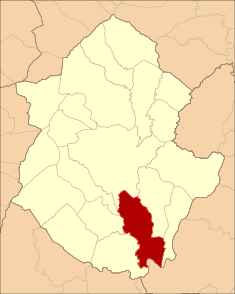- Cerejais (Alfândega da Fé)
-
Cerejais Civil Parish (Freguesia) Official name: Freguesia de Cerejais Country  Portugal
PortugalRegion Norte Subregion Alto Trás-os-Montes District Bragança Municipality Alfândega da Fé Localities Cerejais, Quinta Branca Center Cerejais - elevation 440 m (1,444 ft) - coordinates 41°16′59″N 6°55′4″W / 41.28306°N 6.91778°W Length 8.26 km (5 mi), Northwest-Southeast Width 3.12 km (2 mi), Southwest-Northeast Area 17.0 km2 (7 sq mi) Population 263 (2001) Density 15.47 / km2 (40 / sq mi) LAU Freguesia/Junta Freguesia - location Rua da Igreja, Cerejais, Alfândega da Fé President Junta Abílio Francisco Fernandes President Assembleia Paulo Alexandre Moreno Fernandes Timezone WET (UTC0) - summer (DST) WEST (UTC+1) ISO 3166-2 code PT- Postal Zone 5350-220 Cerejais Area Code & Prefix (+351) 279 XXX XXX Patron Saint São Paulo Parish Address Rua da Igreja
5350-220 CerejaisWebsite: http://www.cerejais.com/ Statistics from INE (2001); geographic detail from Instituto Geográfico Português (2010) Cerejais is a civil parish in the municipality of Alfândega da Fé, in continental Portugal, occupying an area of 17 km² of hilltop escarpments.
Contents
History
A settlement in the area of Cerejais dates back to the 9th century. The origin of its name is also remotely associated with the Ceresales, Cersares and Cersales, a zone historically known for the cultivation of cherries and cherry orchards.[1]
In 1706, from the writings of Father Carvalho da Costa, the settlement had about 70 homes.[2] Later (1758), in the Memórias Paroquiais, the clergy in the settlement are represented by the rector of Alfândega da Fé, receiving annual 8$000 reís stipend.[2] By 1759, the lands of Cerejais were owned by the estate of the Marquis of Távora; that year, the Marquess' lands and property were confiscated by the state, stemming from the events of the Távora affair.[1][2]
In 1855, until that year, the parish pertained to the municipality of Chacim, passing to Torre de Moncorvo and shortly later to Alfândega da Fé.[2]
Even with these changes, by 1926, the settlement had no less than 79 homes and 311 inhabitants.[2]
Geography
The parish of Cerejais is situated on a plateau/bluff, with many of the homes and buildings disperesed around the Sabor River. It is located 8 kilometres from the municipal seat, south of the parish of Alfândega da Fé between the neighbouring parishes of Ferredosa and Sendim da Serra, to the west, and Sendim da Ribeira and Parada, in the east.[1]
The primary buildings in the parish include the pre-school and the primary school (Portuguese: Escola Primária do 1º Ciclo do Ensino Básico), and the seniors centre (Portuguese: Lar da Terceira Idade).[1]
Economy
Its rich and fertile soils, have made Cerejais principally an agricultural community, with the cultivation of cherries, rye, almonds and olives (in addition to the production of olive oil).[1]
Architecture
Religious
- Matriz Church of São Paulo (English: Church of Saint Paul)
- Chapel of São Sebastião (English: Chapel of Saint Sebastian)
- Chapel of the Cavaleiro (English: Chapel of the Knight)
- Chapel of the Louca (English: Chapel of the Crazy Woman)
- Chapel of Santa Ana (English: Chapel of Saint Ana)
- Sanctuary of the Coração de Maria (English: Sanctuary of the Heart of Mary)
Culture
Cerejais celebrates several religious festivals throughout the year, including: the Festival of the Imaculada Conceição (on the last Sunday in May, with a formal procession, images and mass); on the 25 January, the celebrations of Saint Paul (in Cerejais); in the end of May, the celebrations of Nossa Senhora de Fátima (Portuguese: Our Lady of Fátima); and the Festival of São Sebastião at the end of July.[1]
Typical of the artesian local community (calçada stoneworks are common), the village claims as its primary gastronomic foods: the Folar da Páscoa (English: Easter Sweet Bread), sausages and the local dessert known as Os Dorminhões.[1]
References
- Notes
- Sources
- Vilares, João Baptista (1926) (in Portuguese), Monografia do Concelho de Alfândega da Fé (2 ed.), Porto, Portugal: Companhia Portuguesa Editora
Categories:- Bragança District
- Parishes of Alfândega da Fé
Wikimedia Foundation. 2010.

